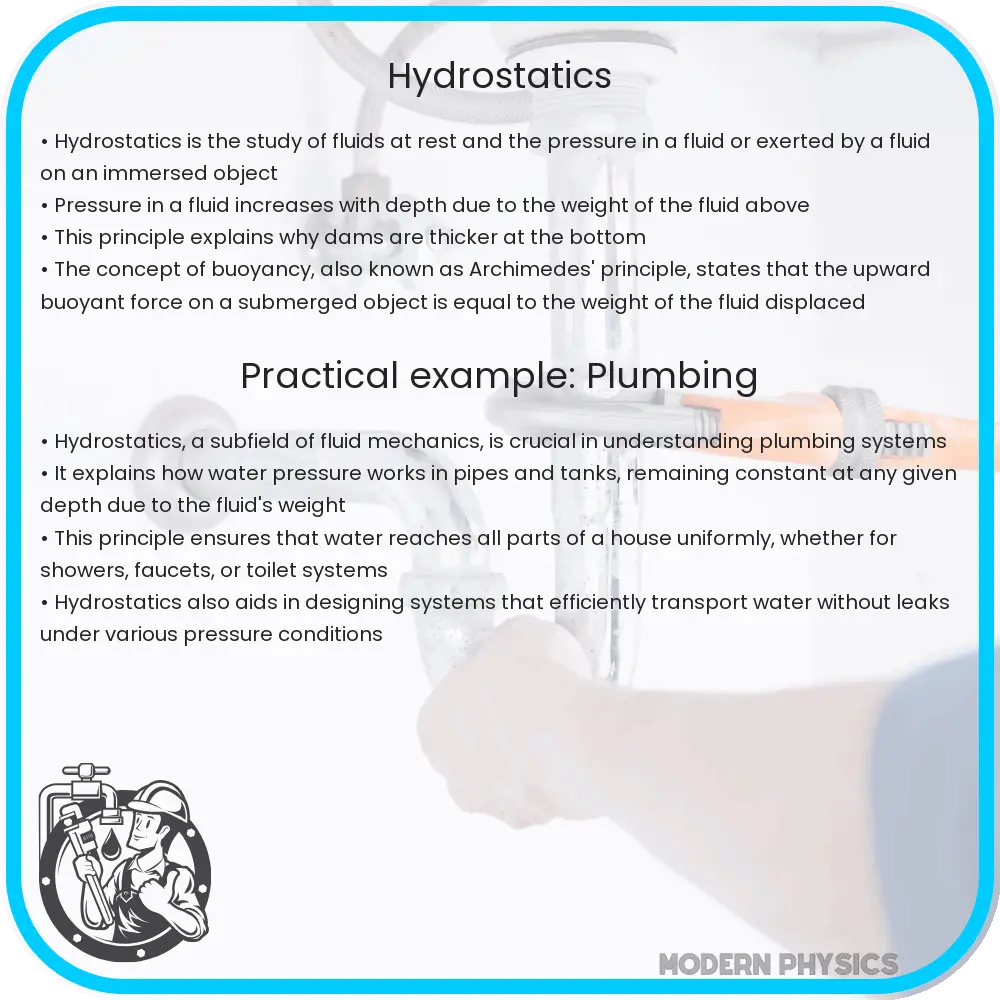Explore the fundamentals of hydrostatics, covering principles like Pascal’s and Archimedes’, hydrostatic forces, applications, and modern developments.

Understanding the Basics of Hydrostatics
Hydrostatics, a sub-branch of fluid mechanics, focuses on the study of fluids at rest. This field is crucial for understanding various natural phenomena and engineering applications, from the behavior of oceans to the design of hydraulic systems.
Key Principles of Hydrostatics
The foundational principles of hydrostatics revolve around the behavior of fluids in a state of equilibrium, where the fluid is not in motion. The most significant principles include:
- Pascal’s Principle: This principle states that pressure applied to an enclosed fluid is transmitted undiminished to every part of the fluid and to the walls of its container. Mathematically, it’s expressed as \( P = \frac{F}{A} \), where \( P \) is the pressure, \( F \) is the force applied, and \( A \) is the area over which the force is applied.
- Archimedes’ Principle: This principle is crucial for understanding buoyancy. It asserts that an object submerged in a fluid is buoyed up by a force equal to the weight of the fluid displaced by the object. The formula for buoyant force is \( F_{buoyancy} = \rho \times V \times g \), where \( \rho \) is the fluid density, \( V \) is the volume of fluid displaced, and \( g \) is the acceleration due to gravity.
Hydrostatic Forces on Surfaces
In hydrostatics, the forces exerted by fluids on submerged surfaces are a major area of study. These forces are vital for understanding the design of dams, tanks, and ships. The hydrostatic force on a surface can be calculated using the equation \( F = p \times A \), where \( p \) is the fluid pressure at the center of gravity of the area and \( A \) is the area of the surface.
Equilibrium in Fluids
Equilibrium in hydrostatics refers to the condition where the net force and net torque on a fluid element are zero. In this state, the fluid does not move, and its pressure varies only with depth due to gravitational effects. This variation is described by the hydrostatic pressure formula \( p = \rho \times g \times h \), where \( h \) is the depth below the surface.
Understanding these principles forms the foundation for more advanced studies in fluid dynamics, where fluid motion and forces are considered. Hydrostatics plays a pivotal role in various engineering fields, including civil, mechanical, and marine engineering.
Applications of Hydrostatics in Engineering and Science
Hydrostatic principles are integral to numerous practical applications. In engineering, these concepts are crucial for designing hydraulic systems like lifts and pumps, which operate based on Pascal’s principle. In marine engineering, hydrostatics informs the design of submarines and ships, particularly in calculating buoyancy and stability. Environmental scientists and engineers use hydrostatics to understand groundwater flow, soil moisture, and the behavior of oceans and atmospheres.
Challenges and Modern Developments
While the fundamental principles of hydrostatics are well-established, ongoing challenges remain in applying these principles to complex and dynamic environments. Advancements in computational fluid dynamics (CFD) have enabled more precise simulations of fluid behavior, including hydrostatic interactions in complex systems. These developments have significant implications for improving the efficiency and safety of hydraulic systems, marine vessels, and environmental management practices.
Integrating Hydrostatics with Other Scientific Disciplines
Hydrostatics does not exist in isolation but intersects with other scientific disciplines. For example, its principles are essential in meteorology for understanding atmospheric pressure systems. In geophysics, hydrostatic equilibrium is a concept used to understand the Earth’s shape and the behavior of its layers. Additionally, in the field of medicine, hydrostatic principles are applied in understanding blood pressure and the mechanics of body fluids.
Conclusion
Hydrostatics, as a branch of fluid mechanics, provides essential insights into the behavior of fluids at rest. From Pascal’s and Archimedes’ principles to the equilibrium conditions of fluids, the concepts of hydrostatics are foundational to numerous scientific and engineering disciplines. The practical applications of these principles are vast, ranging from the design of hydraulic systems to the understanding of natural phenomena. As technology advances, the integration of hydrostatics with computational tools and interdisciplinary approaches continues to evolve, paving the way for more sophisticated and accurate applications in various fields. This continuous development highlights the enduring importance and relevance of hydrostatics in both theoretical and practical domains.
